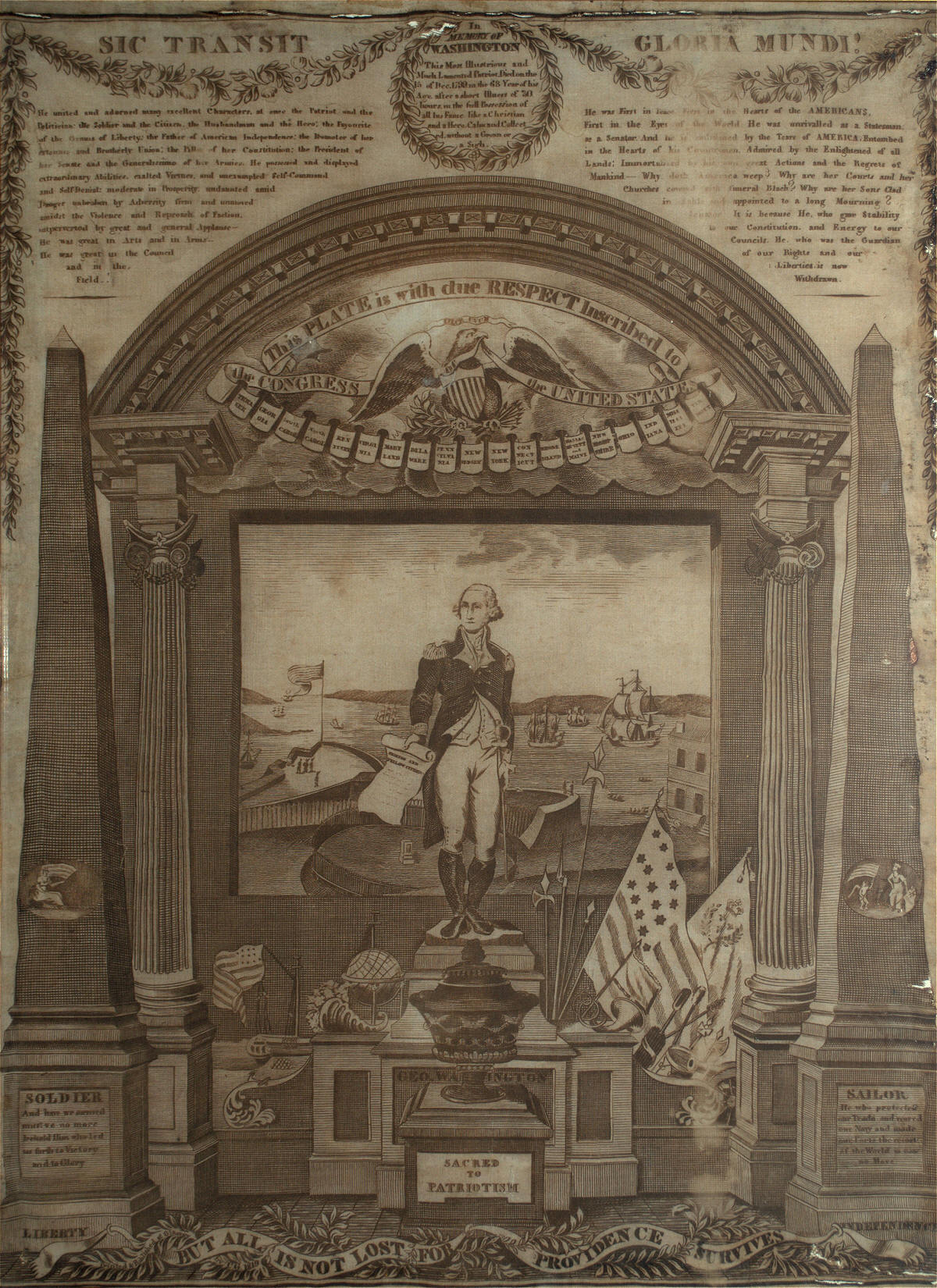|
 This
is a rare example of one of the most elaborate and
beautiful political printed historical American textiles
of the 19th century. "Sic Transit Gloria Mundi!",
translated from the Latin to "Thus passes the glory of
the world!", was printed in Glasgow, Scotland in 1819.
Dedicated to George Washington and to the Congress of
the United States, the large scale engraving on cotton
is based upon an earlier print designed by Charles
Buxton and engraved in 1798 in America by Cornelius
Tiebout. The original engraving ended at the top
arch, but the Glasgow engraving extended to the top with
narrative extolling Washington's virtues. In the
original Tiebout engraving, the ribbon in the federal
eagle's mouth simply reads "E Pluribus Unum", but the
memorial textile reads "This PLATE is with due RESPECT
Inscribed to the CONGRESS of the UNITED STATES."
Likewise, in the original print, the names of the first
16 states are engraved on small shields below the eagle;
in this engraving there are 20 states, through
Mississippi, engraved on 19 shields (with Massachusetts
and Maine on a single shield). Washington, in full
dress uniform, stands atop a pedestal flanked by two
obelisks, resembling the yet to be built Washington
Monument, one labeled "Liberty" dedicated to Soldiers
and the other "Independence" dedicated to Sailors.
The scene behind Washington is of Bowling Green, New
York, and alludes to the British evacuation of New York
on November 25, 1783. An empty pedestal, formerly
the site of an equestrian statue King George III, is
visible behind Washington. In 1770, the British
government erected the king's statue, which soon became
a focal point for protests. On July 9, 1776,
following the reading of the Declaration of
Independence, the statue was toppled and purportedly
melted into bullets to be used by the patriots against
the British. This
is a rare example of one of the most elaborate and
beautiful political printed historical American textiles
of the 19th century. "Sic Transit Gloria Mundi!",
translated from the Latin to "Thus passes the glory of
the world!", was printed in Glasgow, Scotland in 1819.
Dedicated to George Washington and to the Congress of
the United States, the large scale engraving on cotton
is based upon an earlier print designed by Charles
Buxton and engraved in 1798 in America by Cornelius
Tiebout. The original engraving ended at the top
arch, but the Glasgow engraving extended to the top with
narrative extolling Washington's virtues. In the
original Tiebout engraving, the ribbon in the federal
eagle's mouth simply reads "E Pluribus Unum", but the
memorial textile reads "This PLATE is with due RESPECT
Inscribed to the CONGRESS of the UNITED STATES."
Likewise, in the original print, the names of the first
16 states are engraved on small shields below the eagle;
in this engraving there are 20 states, through
Mississippi, engraved on 19 shields (with Massachusetts
and Maine on a single shield). Washington, in full
dress uniform, stands atop a pedestal flanked by two
obelisks, resembling the yet to be built Washington
Monument, one labeled "Liberty" dedicated to Soldiers
and the other "Independence" dedicated to Sailors.
The scene behind Washington is of Bowling Green, New
York, and alludes to the British evacuation of New York
on November 25, 1783. An empty pedestal, formerly
the site of an equestrian statue King George III, is
visible behind Washington. In 1770, the British
government erected the king's statue, which soon became
a focal point for protests. On July 9, 1776,
following the reading of the Declaration of
Independence, the statue was toppled and purportedly
melted into bullets to be used by the patriots against
the British.
The engraving contains
fantastic early American flag symbolism, although
comparison to the original 1798 engraving shows that the
Glasgow engraver did not meticulously follow the flag
designs of the original engraving and thus introduced
errors. Most obvious is the presence of a large
fifteen star flag in a 5-5-5 configuration of
six-pointed stars and eleven stripes, beginning and
ending on white. The original engraving featured
16 stars of five points in a 5-5-5-1 configuration and
thirteen stripes, also beginning and ending on white.
The large flag behind the foreground American flag
features an unusual design of a crown above three
fleur-de-lis and a laurel wreath. In the original
engraving, the equivalent flag consisted of a flag of 15
stripes without a canton. Another small flag of
eleven stars and eleven stripes is opposite the large
flags. The equivalent flag in the original engraving
featured 13 stars in a 5-3-5 configuration with fifteen
stripes. Finally, in the background flying above
the fort at Bowling Green, is a flag of fifteen stripes,
which, in the original engraving, is somewhat white and
nondescript.
The final message to
the observer of the scene, written on ribbon across the
bottom of the print, is one of reassurance for the
future: "BUT ALL IS NOT LOST FOR PROVIDENCE
SURVIVES". The sheer size of the textile, at more
than 19 inches wide by 27 inches tall, combined with the
beauty of the engraving and quality of the printing on
period cotton, makes this one of the finest and rare
American patriotic textiles extant.
|

